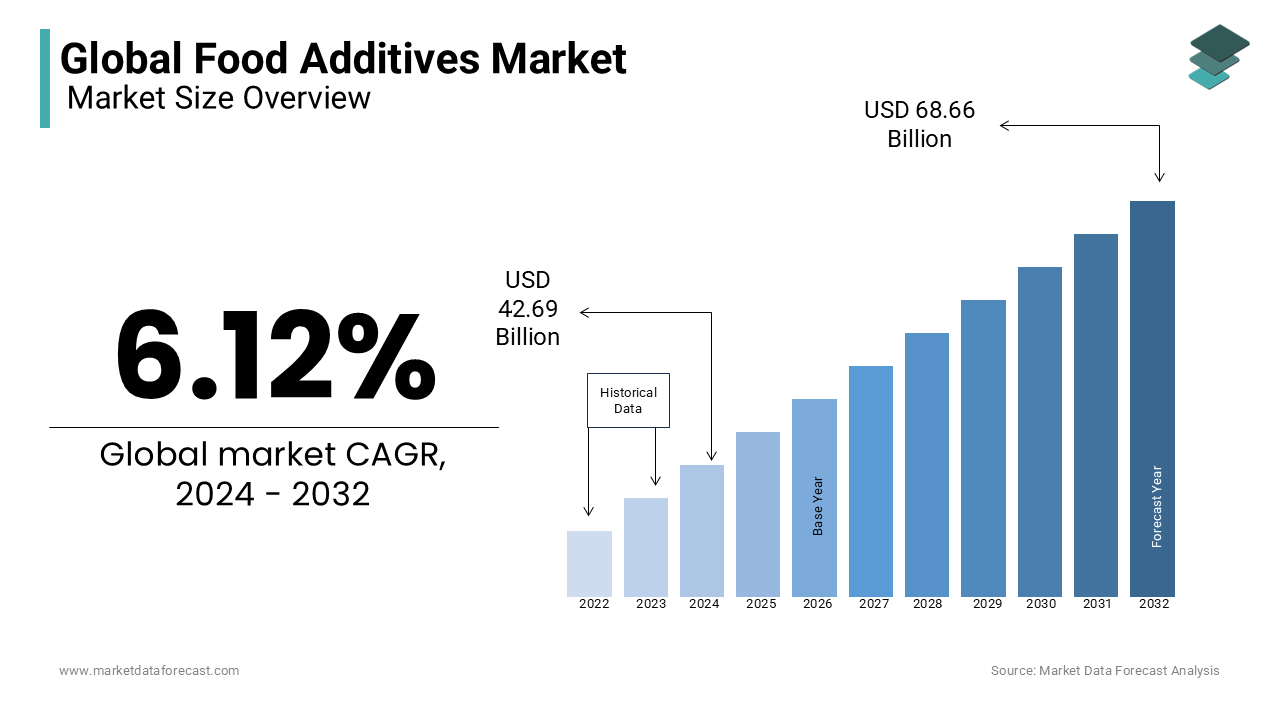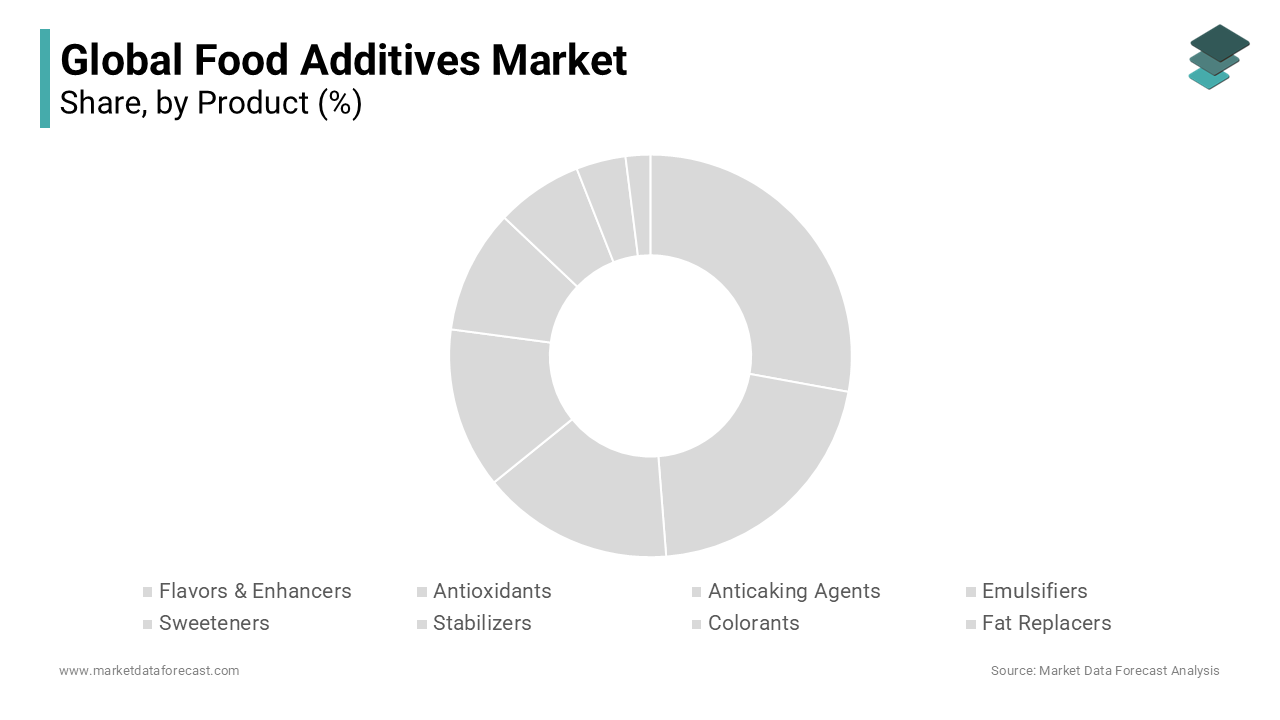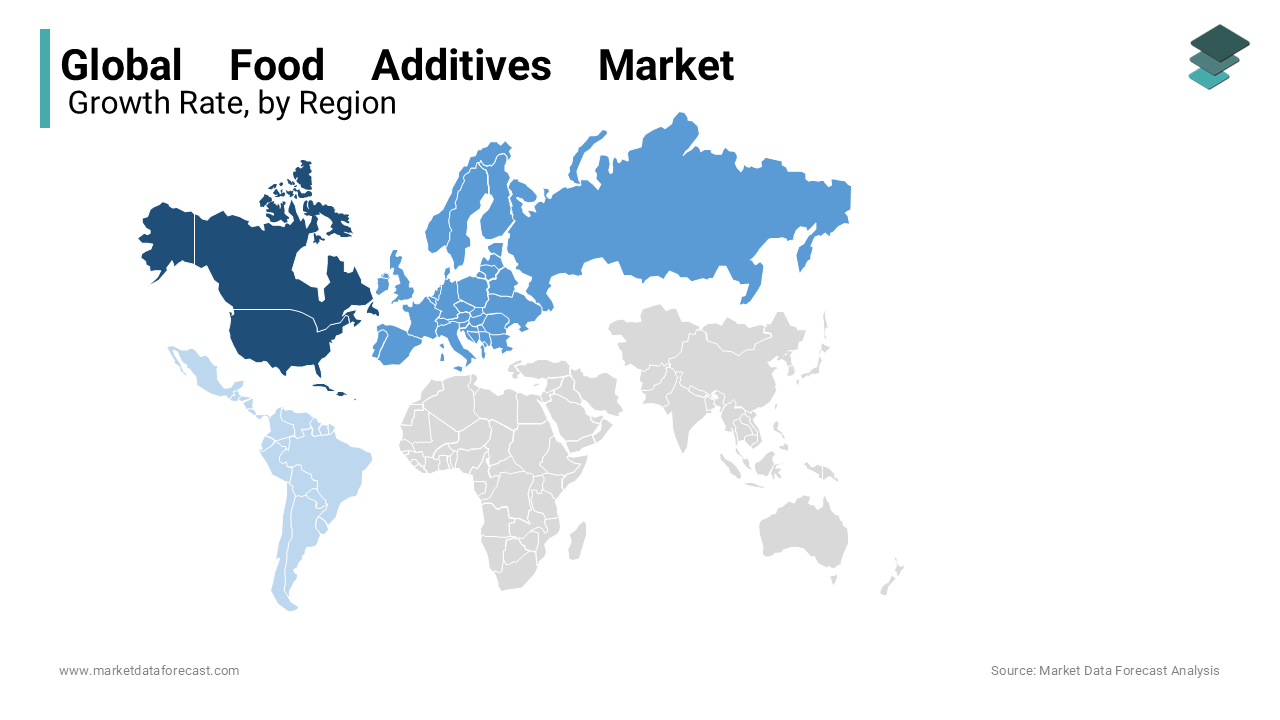Global Food Additives Market Size, Share, Trends, Growth Report & Analysis By Product (Flavors & Enhancers, Antioxidants, Anticaking Agents, Emulsifiers, Sweeteners, Stabilizers, Colorants, Fat Replacers And Others), Application (Confectionary, Hotels, Bakery, Dairy & Frozen Products, Meat, Poultry & Seafood Products, Beverages And Others), Source (Natural And Synthetic), And Regional Forecast 2025 To 2033
Global Food Additives Market Size
The food additives market is expected to expand at a CAGR of 6.12% during the forecast period. The market size was valued at USD 42.69 billion in 2024 and is projected to reach USD 72.86 billion by 2033 from USD 45.30 billion by 2025.

Food additives are widely used in the food and beverage industry and are universally recognized practice around the world. It is a flourishing market in both developed and emerging economies. In addition, according to the UN Population Division of the Department of Social and Economic Affairs, the world population is anticipated to cross 9.6 billion by 2050. In other words, an additional 75 million individuals every year will be required to food. So definitely the consumption of food will go up and this will consequently surge the demand for food additives worldwide.
The challenges faced by the market are the lack of knowledge, understanding, and trust among consumers. For instance, as per a survey conducted in UAE, only 26 percent of the respondents had a basic understanding of food additives, and more than 50 percent of the participants had a perception that organic products didn’t include FAs. Also, a large section of society simply doesn’t have faith in foods with artificial additives.
MARKET DRIVERS
The extensive consumption of fast and ready-to-eat foods is driving the growth of the market.
The demand for high-quality, great-tasting, and long shelf-life comfort or ready-to-eat meals and drinks is rapidly increasing. Apart from this, the booming population, shifting lifestyles, swift urbanization, rising digitalization, and spendable income are influencing the need for food processing, which is ultimately expanding the food additives market. Since the popularity of handy and value-added food items is burgeoning among customers the need for processed foods is increasing. And, this pattern is apparent in all the categories like beverages, snacks, convenience foods, dairy products, etc. Moreover, the United States is the biggest player in terms of fast-food consumption, with people engaging one to three times per week and expanding an expected 1200 dollars annually, which adds to a yearly expenditure of 160 billion dollars. This substantial intake is present in the lifestyle of about 37 percent of adults who eat this daily and over 82 percent of families who consume it weekly. Other major customers involve the United Kingdom in the second position, having more than 46200 fast food chains, and France, with over 50 percent of households frequently visiting these stores.
In other countries, there is a combination of domestic and global brands. For example, Austria and Sweden. Whereas in Asia South Korea witnessed swift expansion of both local and international flavours. Also, because of hectic work schedules in China eating habits of shifted towards fast food with around 41 per cent consuming at least once every week and 97 per cent partaking. Therefore, this picture of the world displays the fast food sector’s effect on the economy and culture.
MARKET RESTRAINTS
Rising demand for organic products, overuse of artificial substances, and unstable raw material costs restrict the growth of the food additives market.
The market expansion is limited due to increased consumer demand for synthetic additives, increased consumer demand for "additive-free" foods or products containing natural additives, limited availability and high cost of natural food additives, and increased consumer conversion to organic food growth in recent years. This is also because of the increased number of administrative actions, advisories, and lawsuits. For instance, in March 2024, a bill was proposed by a California state legislator to prohibit the seven artificial dyes from foods such as cereals, baked items, chips, and other foods served in schools. The list also includes titanium dioxide. In addition, the European Union Commission has also banned this using in any food item.
MARKET OPPORTUNITIES
The rising interest in cell-based foods will provide potential opportunities for the food additives market players.
Animal-based meat is one of the popular sources of protein requirements and has developed significantly to meet food security. Growing animal agricultural products straightaway from cell-based production is a potential alternative to the traditional livestock agricultural system. The food safety issue has become more serious as commercial cell-based food manufacturing keeps expanding. So, this is one of the most critical questions that consumers have and an important prospect for the market.
Moreover, the United States Food and Drug Administration (US FDA) finished its primary premarket consultation for chicken as human food by utilizing animal cell culture technology. It was not the formal approval procedure but a non-compulsory pre-trading discussion. However, this indicates that based on the analysis of data provided by the company the US FDA said that it has no more doubt as of now regarding its safety. At present, over 100 business start-ups are working on cell-based food items worldwide. This industry outlook is moving forward rapidly, with several product and commodity types like poultry, aquatic products, meat, dairy, egg, and fish in the middle for upcoming commercial use. So, we can say that this development will help accelerate the growth of the food additives market.
MARKET CHALLENGES
Negative opinions of consumers are hindering the expansion of the food additives market.
The demand for natural ingredients or preservatives is rapidly increasing. This is due to the negative perception of people of additives and other supplements. The majority of customers directly reject food products with artificial additives, and some don’t even consider natural items, thinking they are counterfeit of the original ones. Also, the rising incidences of heart and other health problems because of the use of synthetic substances in food preparation and snack items. According to research, about 60 percent of meals and other foodstuffs bought by Americans have scientific food additives. This covers flavoring or coloring substances, preservatives, and sweeteners. Apart from this, over 400000 various packed food and beverage items are purchased by US customers every year as the latest products are regularly introduced on the store shelves. And their ultra-processed foods contain greater amounts of sodium, saturated fats, and sugar.
REPORT COVERAGE
|
REPORT METRIC |
DETAILS |
|
Market Size Available |
2024 to 2033 |
|
Base Year |
2024 |
|
Forecast Period |
2025 to 2033 |
|
CAGR |
6.12% |
|
Segments Covered |
By Product, Application, Source, And Region |
|
Various Analyses Covered |
Global, Regional and Country Level Analysis; Segment-Level Analysis; DROC; PESTLE Analysis; Porter’s Five Forces Analysis; Competitive Landscape; Analyst Overview of Investment Opportunities |
|
Regions Covered |
North America, Europe, APAC, Latin America, Middle East & Africa |
|
Market Leaders Profiled |
BASF, Danisco, IFF, Frutarom, DuPont, Archer Daniels Midland, Ajinomoto, Associated British Foods, Royal DSM N.V., ADM, Eastman Chemicals, Givaudan, Tate & Lyle key sweetener brand and SPLENDA sucralose. |
SEGMENT ANALYSIS
Global Food Additives Market Analysis By Product

The sweetener segment is projected to be the biggest revenue contributor to the food additive market in the forecast period. The segment growth is influenced by the growing older population and related health issues. Moreover, the rising incidences of obesity and cardiovascular diseases are due to the increased consumption of sugary or fat-rich foods. Apart from this, people are transitioning towards low-calorie sweeteners. Also, the growing health consciousness and awareness have surged the demand for natural additives, sweeteners, and preservatives. Since there are not many options for natural alternatives the demand for synthetic ingredients will remain high in the coming years.
Global Food Additives Market Analysis By Application
The bakery, along with the confectionery segment, is projected to expand further during the forecast period. The demand is propelled by the wide application to improve their texture, taste, and shelf life in North America and Europe. This includes cakes, bread, tortillas, biscuits, and sugar & chocolate products. Moreover, the frequently used food ingredients or supplements are shelflife stabilizers, fat replacers, sweeteners, and flavors. In addition, the increased consumption of bread and associated goods in the European Union and the United States is accelerating the food additives market growth.
Global Food Additives Market Analysis By Source
The natural segment is expected to grow substantially during the projection period due to the growing inclination for organic products. Also, because it is highly safe to consume and has health benefits the demand is increasing. The rising cognizance of organic and natural food chemicals, preservatives, and sweeteners and the trend of clean-label items are accelerating the segment’s market expansion. However, the cost of high-quality natural additives is restricting the market growth rate. Also, there are growing sales of counterfeit products in the name of organic goods further derailing the industry's development. This has also caused a trust deficit among the customers which results in revenue loss or a reduction in the customer base of small and medium enterprises.
REGIONAL ANALYSIS

North America is leading the food additives market with the increased demand for confectionery and beverages. This trend is due to the busy lifestyle of people, rapid consumption of meat and poultry products and the expanding chain of retail and grocery store industry. Moreover, the regional market is also driven by chemical preservatives. For example, propionates, benzoates, and nitrites. Producers like Corbion NV utilize jasmine extracts and vinegar to reduce the moisture movement of the item. They are using it as citrus powder and anti-oxidants. On the contrary, rising customer knowledge and understanding of the harmful effects of chemical additives are compelling food and drink companies to use organic ingredients instead of these.
Europe's food additives market is a major industry and is anticipated to grow further in the coming years. Besides this, Germany, the United Kingdom, Russia, and France are leading the regional market. Also, it is projected to reach $ 25 billion by 2024. The European Union is moving towards a green economy. So, it is also encouraging the consumption of natural additives. The demand for convenience and healthy foods and beverages is sharply risen since COVID-19. This is also due to the rapid digitalization of mobile payment applications and online meal and snack delivery platforms.
Asia Pacific is an emerging market for food additives. It is majorly dominated by China followed by India. For instance, in March 2024, China National Health Commission (NHC) introduced the new food additive standard GB 2760-2024. This substitutes the earlier GB 2760-2014 standards and becomes the principal and highly important regulatory framework governing the application of artificial flavors, chemicals, and preservatives in China. Another factor fuelling the regional market growth is the rising exports of food additives to Russia since 2022. The reason behind this increased trade is because of Western sanctions making it heavily reliant on Asian countries for supplies.
The food additives market in the Middle East and Africa holds immense potential for domestic and international players. The regional growth is propelled by the growing logistics chain difficulties and inefficiency in the food and beverage industry. This resulted in a change in consumer preference towards artificial sweeteners, preservatives, chemicals and supplements. However, the industry’s progress is decreased by the persistent organic movement and reduced dependency on synthesized compounds because of negative health effects.
Latin America food additives market is diving forward at a steady pace. This can be attributed to the extensive consumption in Brazil. Likewise, in September 2023, Brazil’s ANVISA proposed to modify regulation RDC 778/2023 for food additives. The objective is to improve customer protection by setting up a maximum acceptable threshold limit for ethylene oxide in food additives.
KEY PLAYERS IN THE GLOBAL FOOD ADDITIVES MARKET
Major Players in the food additives market include BASF, Danisco, IFF, Frutarom, DuPont, Archer Daniels Midland, Ajinomoto, Associated British Foods, Royal DSM N.V., ADM, Eastman Chemicals, Givaudan, Tate & Lyle key sweetener brand and SPLENDA sucralose.
RECENT HAPPENINGS IN THE MARKET
- In April 2024, BASF announced that it would introduce its new additive solution, “IrgaCycle,” at CHINAPLAS 2024. It is a facilitator for mechanical recycling. The aim is to substantially grow the sustainability of several plastic uses.
- In December 2023, ADM issued a press release to purchase Revela Foods to strengthen its flavor portfolio. This will cost around USD 240 million in 2023 and is likely to complete the deal in 2024.
DETAILED SEGMENTATION OF GLOBAL FOOD ADDITIVES MARKET INCLUDED IN THIS REPORT
This research report on the global food additives market has been segmented and sub-segmented based on product, application, source, & region.
By Product
- Flavors & Enhancers
- Antioxidants
- Anticaking Agents
- Emulsifiers
- Sweeteners
- Stabilizers
- Colorants
- Fat Replacers
- Others
By Application
- Confectionary
- Hotels
- Bakery
- Dairy & Frozen products
- Meat
- Poultry & Seafood products
- Beverages
- Others
By Source
- Natural
- Synthetic
By Region
- North America
- Europe
- Asia Pacific
- Latin America
- Middle East and Africa
Frequently Asked Questions
1. What is driving the growth of the food additives market?
The growth of the food additives market is driven by increasing demand for processed and convenience foods, advancements in food technology, rising consumer awareness about food safety and quality, and the need for longer shelf life.
2. What are some emerging trends in the food additives market?
Emerging trends in the food additives market include the growing demand for clean-label and natural additives, the development of innovative additives with functional benefits (e.g., probiotics and plant-based ingredients), and the use of advanced technologies for additive production and formulation.
3. What are the growth prospects for the food additives market?
The food additives market is expected to continue growing, driven by urbanization, changing dietary habits, technological advancements, and increasing health and wellness awareness. However, the market also faces challenges related to regulatory compliance, consumer preferences, and competitive pressures.
Related Reports
Access the study in MULTIPLE FORMATS
Purchase options starting from
$ 2500
Didn’t find what you’re looking for?
TALK TO OUR ANALYST TEAM
Need something within your budget?
NO WORRIES! WE GOT YOU COVERED!
Call us on: +1 888 702 9696 (U.S Toll Free)
Write to us: sales@marketdataforecast.com